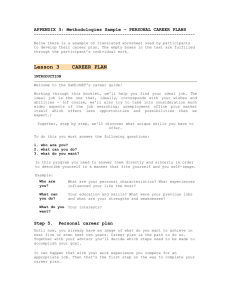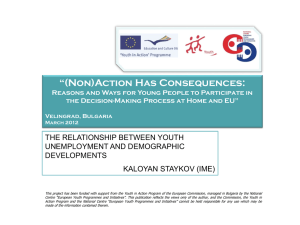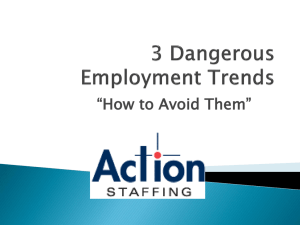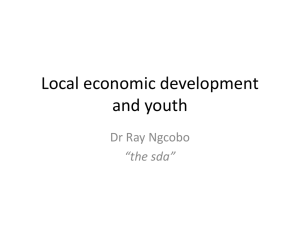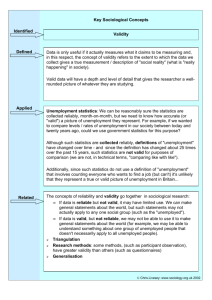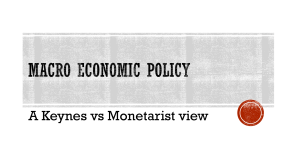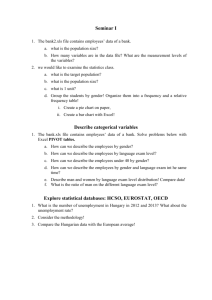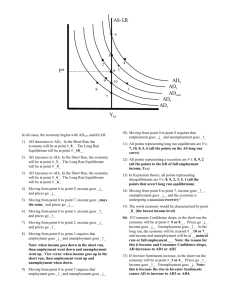The Continuing Unemployment Crisis
advertisement
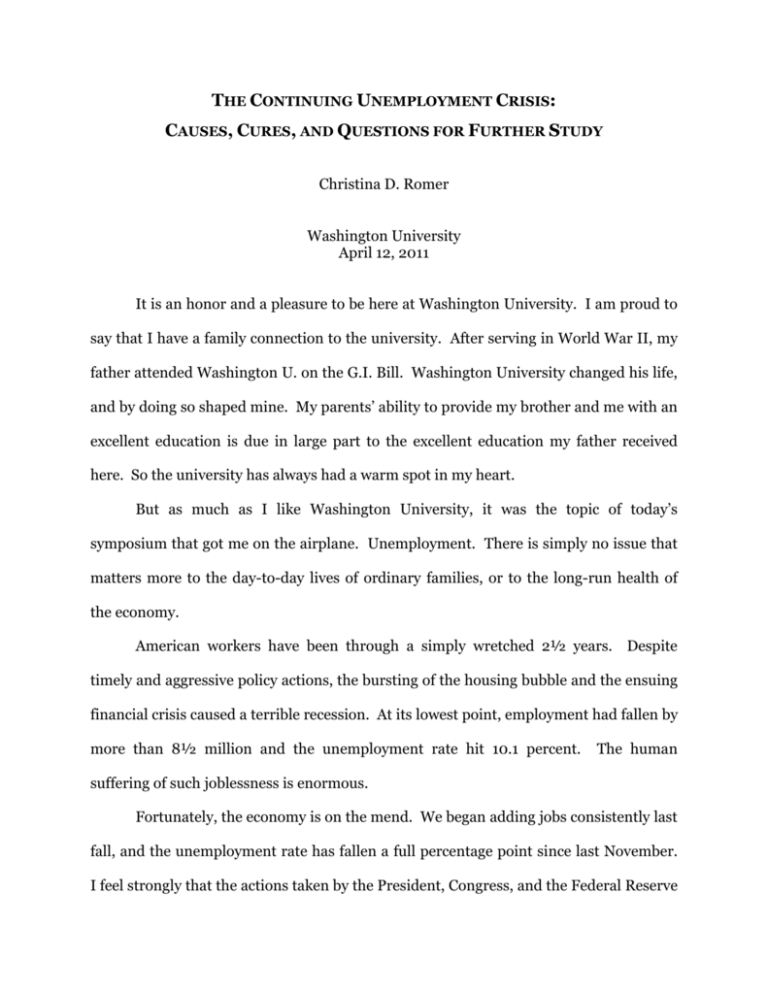
THE CONTINUING UNEMPLOYMENT CRISIS: CAUSES, CURES, AND QUESTIONS FOR FURTHER STUDY Christina D. Romer Washington University April 12, 2011 It is an honor and a pleasure to be here at Washington University. I am proud to say that I have a family connection to the university. After serving in World War II, my father attended Washington U. on the G.I. Bill. Washington University changed his life, and by doing so shaped mine. My parents’ ability to provide my brother and me with an excellent education is due in large part to the excellent education my father received here. So the university has always had a warm spot in my heart. But as much as I like Washington University, it was the topic of today’s symposium that got me on the airplane. Unemployment. There is simply no issue that matters more to the day-to-day lives of ordinary families, or to the long-run health of the economy. American workers have been through a simply wretched 2½ years. Despite timely and aggressive policy actions, the bursting of the housing bubble and the ensuing financial crisis caused a terrible recession. At its lowest point, employment had fallen by more than 8½ million and the unemployment rate hit 10.1 percent. The human suffering of such joblessness is enormous. Fortunately, the economy is on the mend. We began adding jobs consistently last fall, and the unemployment rate has fallen a full percentage point since last November. I feel strongly that the actions taken by the President, Congress, and the Federal Reserve 2 deserve much credit for stopping the freefall, and putting us firmly on the road to recovery. The most recent jobs report showed that we added 216,000 jobs in March and that the unemployment rate fell slightly. The lead article in the New York Times the morning after the employment report was almost giddy. It contained references to “kicking into gear” and “momentum.” It treated the slight rise in job growth as a triumph. Then, in what has to be the understatement of the year, if not the decade, it stated: “Yet March’s numbers also offered more than a few cautionary signs that the national economy was not cured of all its ills.”1 Talk about the tyranny of low expectations. The unemployment rate is still 8.8 percent. How could anyone possibly think the economy was cured of all its ills? 13.5 million Americans are looking for a job but cannot find one. 6.1 million of them have been without a job for more than six months. In my talk this afternoon, I want to discuss the causes of this continued high unemployment, and what policymakers should be doing about it. I also want to talk more broadly about what we know about unemployment and what we still need to figure out. There are many topics in pressing need of more research—which makes the project being started here at Washington University incredibly important. I. DIAGNOSING THE CURRENT UNEMPLOYMENT PROBLEM The place to start is with the causes and prospects for our current unemployment problem. At close to 9 percent, our unemployment rate remains very high. Debate is raging about whether that number reflects our new normal unemployment rate, or 3 whether it is still a consequence of slow growth and inadequate demand. I believe strongly that it is not the new normal. Rather, it is still the old cyclical. Evidence that Unemployment Isn’t Structural. Those who believe that the high unemployment rate is here to stay say that what we have now is due to structural factors. As I described in a recent New York Times column, the evidence for this view is weak.2 Consider the commonly expressed concern about changing industrial composition. There is no question that the bust in housing and the financial crisis have likely led to long-lasting declines in employment in construction and finance. But it is a big jump from that fact to saying that our severely elevated unemployment is due to skills mismatch. First, the numbers just don’t add up. Today, unemployed construction and finance workers number about 1.3 million more than before the crisis. Even in the extremely unrealistic case where none of these unemployed workers finds a job again, this displacement would raise the normal unemployment rate only by about a percentage point. More fundamentally, workers who lost their jobs in construction and finance are leaving unemployment at about the same rate as workers who lost their jobs in less troubled industries.3 The sad fact is that the exit rate out of unemployment is low for everyone. Thus, the trouble is not skills mismatch, it is a general lack of jobs. Another story one hears is that the crash of the housing market, which has left 11 million families owing more on their mortgages than their homes are currently worth, has lowered labor mobility. Unemployed homeowners cannot move to where the jobs are because they would have to realize the losses on their homes or default on their 4 mortgages. But a recent study shows that mobility is no lower in states with more underwater mortgages, even controlling for the fact that such states also tend to have higher unemployment.4 Thus, so-called “house lock” does not seem to be causing structural unemployment. Now I do not want to go too far. My own guess is that the terrible crisis and recession we have been through have taken some toll on normal unemployment. The Survey of Professional Forecasters conducted by the Federal Reserve Bank of Philadelphia asks its respondents once a year what they think the natural rate of unemployment is. In the third quarter of 2010, the median response was 5.78 percent, about a percentage point higher than the median in the third quarter of 2007, before the recession began.5 That strikes me as about right. Continuing Cyclical Unemployment. If normal unemployment is still less than 6 percent, then much of our current high unemployment is due to cyclical factors. It reflects the fact that aggregate demand has not returned to its pre-crisis trend. Consumers are still hesitant to spend because of high levels of debt and unemployment. Firms are hesitant to invest because of a dearth of customers and uncertainty about the future. There has been much hand-wringing about whether we might be experiencing a “jobless” recovery. I think of that as being a situation where job growth is low, given the rate of output growth. What we are experiencing is, in fact, closer to a “growthless” recovery than to a jobless one. GDP started to grow more than a year and a half ago. But with the exception of a couple of quarters, growth has not been noticeably above its trend rate of about 2.5 percent. This is not the kind of growth one needs or expects coming out of a deep 5 recession. To bring the unemployment rate down and repair the labor market damage caused by the recession, growth needs to be far above its trend level. In the year and a half following the trough of the 1982 recession, real GDP growth averaged over 7 percent. Coming out of the Great Depression, GDP growth averaged more than 9 percent for the four years in the mid-1930s. Such rapid rates of GDP growth translated into very rapid job growth in both episodes. That is why I don’t rejoice at the news that we added 216,000 jobs in March. About 100,000 jobs are needed each month just to keep up with the normal growth of the labor force and so hold the unemployment rate steady. At this rate of job growth, it would take most of a decade to replace the 8½ million jobs lost in the recession and get us back to the previous trend level of employment. Job growth close to half a million each month is the kind of number we need and should be aiming for. Future Prospects. Unfortunately, I see little reason to hope that the economy on its own will generate much more rapid job growth, at least in the near term. Last December, there were signs that GDP growth was accelerating, at least somewhat. But unrest in the Middle East, a tsunami in Japan, and a continuing debt crisis in Europe have each shaved a bit off U.S. growth. As a result, it looks as though growth will remain tepid. Unemployment will therefore also likely remain severely elevated for a good while longer. While I am confident that most of the current elevated unemployment is due to cyclical factors, I am not at all sure that structural unemployment will not become more important going forward. The recent reports of firms specifying in help-wanted ads that only people currently employed will be considered are deeply troubling.6 They suggest that prolonged unemployment does have a stigma effect, even in a recession as severe as 6 this one. More generally, a range of studies suggest that there is a link between prolonged cyclical unemployment and increased normal unemployment. A study by Laurence Ball, for example, shows that prolonged recession in a number of European countries in the early 1980s appears to have raised their normal unemployment rate substantially. In contrast, the shorter U.S. and Canadian recessions appear to have done less lasting damage.7 A microeconomic study by von Wachter, Song, and Manchester finds lasting negative effects of unemployment on workers’ earnings and employment prospects for many years.8 One area where policymakers desperately need more research is on this possible connection between cyclical and structural unemployment. If policymakers were more certain that such a link existed, the case for countercyclical policy would surely be stronger. Identifying the source of such a linkage would also inform the kind of countercyclical policies pursued. For example, if unemployment causes lasting damage by allowing workers’ skills to deteriorate, then policies encouraging job-sharing rather than complete unemployment for some become more attractive. II. REDUCING CYCLICAL UNEMPLOYMENT Having argued that most of the unemployment we are experiencing is still cyclical leads naturally to the next question—what can we do to reduce cyclical unemployment? Since the problem is a lack of demand, the solution at a broad level is obviously to increase demand. But how to do that? Here again, there is much that we know, but also much that still needs additional research. Encouraging the Private Sector. I think we would all agree that the best 7 thing would be for private sector demand to come back on its own. But, as I have suggested, there are a number of reasons why that is unlikely to happen. Tight credit conditions, high debt loads, and world tensions are all conspiring to hold back consumer spending and business investment. What about the argument that business investment and hiring would rise if only we cut government spending and ended activist policy? I am very skeptical of the notion that fiscal austerity can be expansionary. An excellent study done by the International Monetary Fund last fall shows clearly that over a large sample of episodes in developed countries, deliberate fiscal contractions on net reduced output and employment.9 That is, any positive effect of budget tightening on confidence is outweighed by the direct negative impact of lower government spending or higher taxes. What makes this study so persuasive is that it identifies deliberate fiscal contractions from primary sources, and shows how previous studies that reached a different conclusion had misclassified a number of episodes. This finding is also consistent with the recent experience of a number of European countries. The United Kingdom, which instituted severe budget tightening last year, saw its moderate expansion give way to further declines in GDP at the end of 2010. And Ireland, Greece, Portugal, and Spain are finding it nearly impossible to grow as they undergo deep fiscal contractions. I am more sympathetic to the notion that uncertainty is holding back investment and consumer spending. A study I did on the Great Crash of the stock market in 1929, and a series of papers by Nick Bloom on postwar stock price volatility, suggest that uncertainty does depress spending and output.10 But, I feel we know little about what causes uncertainty. Some lawmakers assert 8 with confidence that the health reform legislation passed last year or the fiscal stimulus is making businesses uncertain. Alan Greenspan has suggested that government activism is generating uncertainty.11 My own strong suspicion is that firms and financial institutions are skittish because they have been through a brutal financial crisis and recession. Importantly, there is almost no research on this topic. Several conservative friends recommended Amity Shlaes’s book on the Great Depression to me, as a study showing that Roosevelt’s activism caused uncertainty and slowed recovery in the mid1930s.12 I recently assigned the book to my class so that we could study it closely. My students and I were struck by the degree to which it was lacking in solid evidence— statistical, anecdotal, or otherwise. Given that the uncertainty hypothesis is being used to determine policy, economists need to study it closely. We need to marshal empirical evidence to either back it up or refute it. We need to figure out what types of uncertainty might be most important, and what their determinants are. Monetary Policy. While we know little about what causes uncertainty and how much it matters, there is clear empirical evidence that monetary and fiscal expansion aid growth and reduce cyclical unemployment. Let me start with monetary policy. The first conversation I ever had with the President-Elect began with him saying the Federal Reserve was out of ammunition, so we needed to use fiscal policy. Now I had written a paper showing that monetary expansion was very useful in the 1930s, despite the fact that nominal interest rates were near zero.13 So in my nervousness, I immediately launched into a discussion of how the Federal Reserve was not out of 9 ammunition, and we ended up having a wonderful discussion of Roosevelt and the Great Depression. Only afterwards, when I was recounting the conversation to my husband, did he point out that the first words out of my mouth were to tell the President-Elect that he was wrong. I feel very fortunate that he hired me anyway. A number of recent papers have evaluated the efficacy of the Federal Reserve’s purchases of unconventional assets such as mortgage-backed securities and long-term government bonds in 2009 and again starting in November of 2010. These studies find that this so-called “quantitative easing” has lowered longer-term interest rates, mitigated deflationary expectations, and lowered the price of the dollar in foreign exchange markets.14 All of these developments are conducive to faster employment growth. It is for this reason that I feel strongly that the Federal Reserve should be using these tools more aggressively. Core inflation remains well below the Federal Reserve’s implicit target, while unemployment is painfully high. I can see no reason for not continuing and indeed expanding the current round of quantitative easing. The Federal Reserve should also consider a better communications strategy. Markets are expecting the Federal Reserve to raise the federal funds rate sooner than I think is plausible. If the Federal Reserve conveyed its intentions more clearly, this could lower long-term rates by giving markets a more accurate picture of the likely path of short-term rates. While recent research suggests that unconventional monetary policy is effective, much uncertainty remains about the size of the effects and how unconventional policy could best be used. So this is another fruitful area of research. Rather than focusing just on the recent episode in the United States, it would be useful to look at other countries 10 and other time periods. More fundamentally, monetary policy in the United States has now neared or hit the zero nominal bound on interest rates twice in the last ten years. If monetary policy is to remain the frontline tool for macroeconomic stabilization, we need to figure out ways to keep it effective. This will surely involve learning how to use quantitative easing with more precision. It could also involve more fundamental changes, such as adopting a policy of targeting a path for the price level, or even accepting a slightly higher target for inflation. Fiscal Policy. Let me turn now to fiscal policy. As my first conversation with the President-elect suggested, the Administration’s signature response to the financial crisis and recession was to be a bold fiscal stimulus. And despite my initial discussion of Roosevelt’s monetary policy, I was fiscal expansion’s strongest proponent. Everything that I knew as a macroeconomist and an economic historian suggested that it was our best shot at stopping the freefall. Virtually every study of fiscal policy finds that changes in spending and taxes have substantial effects on output and employment. How large those estimated effects are depends greatly on how well the researcher measures what else is going on in the economy. Many studies look at what happens to output during wars as a way of gauging the impact of an increase in government spending.15 Wartime spending has the benefit that it is not driven by other factors that might be affecting output. However, it does tend to be highly correlated with another type of fiscal policy—tax increases. The Korean War, for example, was fought largely out of current revenues. That output and employment rise strongly in wars, despite the huge tax increases that have accompanied our largest 11 ones, suggests that government spending has very substantial real effects. On the tax side, a study I did with my husband, David Romer, used narrative sources, such as presidential speeches and congressional reports, to identify tax changes that were not taken in response to other factors affecting output. We looked particularly at tax changes made for ideological reasons, such as a belief in the long-run incentive effects of lower marginal tax rates. We found very large short-run output effects. A tax cut of 1 percent of GDP increased GDP by between 2 and 3 percent.16 Because of the compelling historical evidence that fiscal stimulus raises output relative to what otherwise would have occurred, the United States and virtually every other G-20 country undertook fiscal expansion in the fall of 2008 and early 2009. Indeed, the United States was substantially ahead of the pack, passing a $150 billion stimulus in February 2008, just as the housing bust was beginning to unfold. The Obama administration then led the charge for the much larger Recovery Act, passed in February 2009. Persuading skeptics that those two fiscal expansions were effective has been difficult. In both cases, the positive macroeconomic impact of the stimulus was fighting against a strong downward tide of the economy. Separating the deteriorating baseline from the positive effect of the stimulus requires a willingness to go beyond talking points and actually debate counterfactuals—something surprisingly few policymakers and even economists are willing to do. In my view, the most convincing research about the effects of the 2008 and 2009 stimulus actions uses disaggregated data and natural experiments. A study by Parker, Souleles, Johnson, and McClelland looks at individual consumer expenditure data around the time of the 2008 tax rebate.17 It takes advantage of the fact that there was 12 random variation across families in when they received their rebate, because there were limits to how fast the Treasury could write the checks. This study finds that a surprisingly large fraction of consumers not only spent their rebate checks quickly, but took them as a spur to spend even more on big-ticket items, notably cars. Another study looked particularly at the state fiscal relief component of the 2009 Recovery Act. About $120 billion of Federal money was given to state and local governments to help them maintain employment and services. A substantial fraction of this spending was determined not by current economic conditions in a state, but by a formula tied to historical levels of Medicaid spending. This implies that there was a somewhat random element to the amount of aid that various states received. The authors find that states that received more state fiscal relief because of these historical factors had significantly stronger employment growth, relative to predicted, than states that received less.18 I believe that when scholars finish analyzing both the U.S. and international evidence, the bottom line will be that fiscal stimulus is, and was in this past recession, a key tool to fight cyclical unemployment. For this reason, I think that the additional fiscal actions taken in December will be helpful in dealing with our continuing unemployment problem. Those actions included a 2 percent cut on the worker side of the Social Security tax, and another year of extended unemployment insurance. They also involved a two-year extension of the Bush tax cuts, including—regrettably in my view—those for the wealthiest taxpayers. Importantly, these actions mainly prevented a severe fiscal contraction that otherwise would have occurred. The Recovery Act winds down strongly this year, and the Bush tax cuts were set to expire. So there is not a genuine jolt of additional stimulus. 13 But the December actions were essential to preventing what very likely would have been a rise in unemployment had no offsetting fiscal expansion occurred. I strongly support doing even more fiscal expansion in the short run. Before you decide that I am a Keynesian nut who does not understand that we have a huge deficit, let me explain. I am deeply concerned about our budget problems. The projections for entitlement spending and revenues over the next 25 years are truly terrifying. We are on an unsustainable path that will ruin us if we do not change our ways. That is why I was happy to sign an op-ed written by a bipartisan group of ten former chairs of the Council of Economic Advisers, including Washington U.’s own Murray Weidenbaum, urging policymakers to move quickly on the recommendations of the Bowles-Simpson fiscal commission.19 But it seems to me that Congress is currently on exactly the wrong trajectory. It is obsessing about cutting current spending, when we need it to support the economy, and doing nothing about the long-run deficit, which will eventually bankrupt us if we do not do something. A far more sensible strategy would be to take prudent additional stimulus actions today, as part of a comprehensive plan to cut the deficit over time. That is in fact exactly what one of the alternative fiscal commissions proposed. The commission chaired by former Senator Pete Domenici and former CBO director Alice Rivlin included a $650 billion payroll tax holiday in 2011, with a comprehensive plan that gets the deficit completely under control over the next decade.20 If Congress were willing to go along, what additional fiscal measures would be sensible? The President has recommended more public investment on infrastructure, innovation, and education. All of these have the benefit of reducing unemployment in the short run and leaving us better off in the long run. 14 Given the continuing budget crises of state and local governments, and the evidence that federal aid to states raises employment, I would gladly do more of this. Many states are going to have to undertake structural changes in their budgets—my home state of California is first in line. But states and localities are still being battered by the reduced revenues resulting from high unemployment. More federal money to help them maintain employment and services would be money very well spent. Finally, and most importantly, I would do a temporary cut in the employer’s side of the payroll tax. This would certainly have the usual beneficial effect on aggregate demand. But it could also have desirable incentive effects. By reducing the cost of hiring workers, it could encourage firms to speed employment growth. This question of incentive effects is another area where I feel additional research is desperately needed. In the fall of 2009, those of us at the Council of Economic Advisers, together with a number of other economists in the administration, got very excited about a new jobs tax credit. This is essentially a payroll tax cut for firms only for new hires. This seemed to us a sensible way to encourage substantial hiring at a moderate cost. It was a very tough sell to Congress and, frankly, to the President. The one experiment with such a credit in the 1970s was widely viewed as a flop. Few firms even knew about the 1977 jobs credit, much less took advantage of it.21 And when asked about a new jobs tax credit in 2009, the heads of a few large corporations casually asserted that such a credit would not affect their hiring behavior. Our passionate band tried to make the case that a new jobs tax credit could be very effective. CEA economists obtained data on the fraction of firms that might be eligible, and used plausible response parameters to show that such a credit could have a 15 very high bang for the buck. Alan Krueger at Treasury worked with outside economists to survey a representative sample of human resource managers, to see how many thought their companies would respond. A surprisingly large fraction said it would affect their hiring behavior. In the end, the President endorsed the measure, and a slimmed down hiring credit was passed as the HIRE Act in March of 2010. The final version was decidedly smaller and more complicated than our original proposal, and it is unclear how many firms have been aware of it. The Treasury Department estimates that more than 10 million workers have been hired whose employers could qualify for the credit.22 However, we won’t know how many employers may actually have been responding to the credit until they file their tax returns this spring. It would be great if researchers could figure out whether such policies could be effective and how they should be designed. Again, the experience of other countries might be informative. Also, states have periodically used such hiring incentives. Their experience could perhaps provide a model for a national policy. I fear we are missing out on a potentially valuable tool because of lack of information and research. The bottom line of all of this discussion is that we do possess many tools for curing cyclical unemployment—both monetary and fiscal—and I feel it is shameful that we are not using them more aggressively. III. REDUCING STRUCTURAL UNEMPLOYMENT AND RAISING STANDARDS OF LIVING So far, I have talked in detail about what we could do to reduce cyclical unemployment. It is appropriate to spend most of my time on this because cyclical unemployment represents the lion’s share of our current unemployment crisis. 16 But structural unemployment has risen somewhat nationwide, and could rise further if we don’t reduce cyclical unemployment quickly. And certain regions of the country have been plagued by high unemployment since long before the recent recession began. Michigan, for example, has had an unemployment rate over 7 percent for much of its recent history. More fundamentally, living standards have stagnated for the typical family over at least the last decade. Real median family income was essentially flat in the first seven years of the 2000s, and then fell during the recession.23 As a result, the typical family can afford to buy less today than it could a decade ago. Structural unemployment and stagnating standards of living are not what any of us want for our children. It is the antithesis of the American dream. So let me spend the rest of my time discussing what we could do to restore income growth and keep normal unemployment down. Education. Education and training are surely part of the answer to both these problems. To the limited degree that sectoral change has caused a mismatch between the skills needed in available jobs and those possessed by the unemployed, job training could certainly help. It is probably unrealistic to turn “the carpenter into a nurse,” as Federal Reserve Bank of Philadelphia president Charles Plosser suggested needed to be done.24 But well targeted programs could surely change traditional construction workers into solar panel installers and home weatherization technicians. More generally, better education can prepare today’s workers to cope with sectoral change in the future. Like many professors, I have been following with interest a new sociological study that suggests colleges are not demanding enough of students, and that we are not improving complex reasoning and critical thinking skills 17 adequately.25 Complex reasoning and critical thinking skills are what all students need to excel in today’s labor market. And they are exactly the skills that will allow our students to move seamlessly from one field to another as industries rise and fall in the future. I won’t claim to know exactly how to improve the effectiveness of our educational system. But there are many dedicated experts with lots of ideas. We should be listening to them, and encouraging the best research possible in this area. What an economist can offer is the evidence that such investments in better education are worthwhile. They not only help increase worker flexibility and lower structural unemployment, they are a fundamental source of rising standards of living. Empirical studies show that the economic returns to education both for individuals and for the country as a whole are substantial.26 A more educated labor force is a more productive labor force. And greater labor productivity is the surest way to increase standards of living over time. International Trade. In thinking about structural unemployment and standards of living, it is easy to view international trade as a curse. We can all see the devastation that the movement of manufacturing jobs to other countries has brought to the industrial Midwest, for example. What we often miss, however, is the fact that trade also creates many jobs and reduces the cost of many goods we wish to buy. Like education or technological progress, trade is something that can increase our productivity and raise standards of living. The key challenge is to reap the overall rewards of trade while dealing with any casualties. If trade devastates certain areas or types of workers, the government has an 18 obligation to help reconstruct lives and communities. Incredibly interesting and important work examines the value of place-based policies to regenerate areas where jobs have moved overseas.27 Everything from tax incentives for industries to relocate to such communities, to intensive retraining efforts, to targeted public investment can help make troubled areas thrive again. This is another area where additional research would be very valuable. Policymakers desperately need to know the most effective way to create jobs and rekindle growth in areas that are struggling with declining industries. In addition to coping with the adverse consequences of trade, we should do all that we can to ensure that American workers benefit as much as possible from international competition. The obvious way to do this is to encourage the growth of our export sector. I suspect that commercial diplomacy doesn’t affect trade flows very much, but it can’t hurt. China’s stubborn refusal to let its currency appreciate, on the other hand, surely does have an impact on our net exports. We should continue to push for a genuine market-based exchange rate for the yuan. More generally, we should encourage not only China, but other large trade surplus countries such as Germany and Japan, to do more to stimulate their domestic demand. A stronger social safety net in China or a reduction in payroll taxes in Germany would create more demand for consumer goods, including those produced in the United States. Innovation. Probably the surest way to ensure that American living standards rise again and that we are creating new industries to take the place of declining ones is to encourage innovation. Over the long sweep of American history, the main source of growth and rising living standards has been technological progress.28 We need to make 19 sure that innovation doesn’t falter. The most useful thing the government can do right now to encourage innovation is to take the measures I mentioned before to hasten the economic recovery. Innovation is very procyclical.29 If there are buyers for products, American entrepreneurs will come up with new and enticing ones. A healthy economy is thus a key ingredient to rapid innovation. But is there more that policymakers could do to encourage innovation? The answer is surely yes, but there needs to be a guiding principle. And that principle is that the government should leave the private sector free to do what it is good at, and get involved only where there is some sort of market failure—where there is some reason the private sector innovation machine isn’t likely to work well. One of my favorite interchanges on this topic occurred on a trip to China last spring. As part of an official delegation for the Strategic and Economic Dialogue, I was meeting with a group of Chinese academics and business people. Someone asked me what the next U.S. growth industry was. Without hesitating, I said I didn’t know, and more importantly, it wasn’t my job to know. In the United States, the President’s economic advisers don’t decide where firms should be investing and what industries should be growing. We trust the private sector to figure out where the best opportunities are and let profits be the ultimate guiding force. But there are areas where the private sector won’t make the best decisions for the country as a whole. The most obvious concerns investment in basic scientific research. The social returns from such research are enormous, but the private returns are limited. Often the lag between a fundamental discovery and a marketable product is several decades. And while some ideas can be patented, many cannot. As a result, it is very 20 hard for a private investor to capture much of the return from a discovery. All of this results in the private sector investing too little in basic research. This is where government can play a positive role. It can subsidize basic research and ensure that the results are broadly available for the private sector to use and apply. The Administration did this aggressively in the Recovery Act, which included some $18 billion for research funding. The government can also encourage basic research in the private sector. The administration’s budget proposes that the Research and Experimentation tax credit be increased and made permanent, so that private firms have a greater incentive to invest in R&D. We can also improve our patent system and fight to protect intellectual property rights abroad, so that private entrepreneurs reap the rewards of the research investments they make. Manufacturing. The last topic I want to touch on is the future of manufacturing. Or really, the question of whether manufacturing is important to the future of U.S. unemployment and income growth. This is a topic that President Obama cares deeply about. I will never forget a rollicking economic briefing we had on this topic in the Oval Office. Most of our daily economic briefings were short and targeted at immediate economic problems and policy issues. But occasionally, we took time for longer-range discussions. This one turned into a sort of debate on the future and importance of manufacturing. It pitted Michael Greenstone, the chief economist at CEA and a professor at MIT, against Ron Bloom, the President’s manufacturing czar. This was just the sort of discussion the President loves. Much has been made of the sometimes colorful clashes between members of the economics team. But the truth 21 is, the President often found it helpful to hear both sides of a topic argued passionately. And that is what we did that day in the Oval. Many believe that saving manufacturing in the United States is critically important. It is one of the few sources of well-paying jobs for less-educated workers. And I agree that it once served that purpose. Empirical studies suggest that in the early postwar period, manufacturing did seem to pay more than other sectors for a given level of skills.30 This fact allowed many less-educated workers to thrive and achieve a middleclass lifestyle for their families. But international competition has increased greatly over the last few decades. In many areas where American manufacturing firms were once dominant, emerging market economies are now surging. As a result, American companies are scrambling to reduce costs. Firms are bargaining for leaner wages and are switching to more productive technologies. Most of these new technologies are incredibly complicated. As CEA chair, I visited a Ford engine factory in Cleveland that looked more like a Berkeley or Washington U. computer lab than an assembly line. Not surprisingly, the educational requirements in manufacturing have risen noticeably. Today, almost half of those employed in manufacturing have some college education, up from just over 20 percent in 1969.31 In this environment, workers are going to do well only if they are highly skilled, well educated, and productive. My strong suspicion is that better trained workers are more likely to save American manufacturing, than American manufacturing is likely to save less educated workers. Of course, the government should take sensible steps to keep this key part of our 22 economy healthy. Many of the most important are the ones I have already mentioned: stimulating exports, encouraging innovation, and subsidizing education and training. These steps are good for American growth in general, and for manufacturing growth in particular. Such steps would allow American manufacturing to flourish again, not by propping up uncompetitive companies, but by nurturing a genuine comparative advantage. Now many of the things that we could do to lower structural unemployment and enhance growth cost money. Better education, more basic scientific research, and programs to help communities devastated by trade all come with a price tag—often not large, but not trivial either. Some will say that given our desperate long-run fiscal situation, we can't possibly spend more on anything. I think this is deeply wrong. As I have mentioned, I strongly support a comprehensive plan to deal with the long-run budget deficit. But just as more short-run stimulus can be part of such a long-run plan, so can sensible investment spending. Fiscal austerity shouldn’t mean cutting everything regardless of how effective it is. Within an aggressive long-run policy of restraint, we should also rearrange spending from programs that do little to aid growth, such as many farm subsidies and weapon systems that even the Pentagon doesn't want, to the kinds of prudent investments in our future standard of living that I have described. This is ultimately good not only for our children and grandchildren's prosperity, but for the budget itself. CONCLUSION People often ask me what my happiest day in the White House was. For me, there is no competition—it was December 3rd, 2009. That was the day of the White 23 House jobs summit. A number of us had spent the summer and fall agitating for more fiscal measures to lower unemployment, and now the Administration was ready to move forward. The President was preparing to announce a range of measures, including more state fiscal relief, more infrastructure investment, and a hiring tax credit.32 We had a large group of business leaders, labor representatives, and economists to the White House to talk about these and other jobs measures. Then, at around 6 p.m. that day, the employment report for November arrived in my office. One of the jobs of the CEA chair is to look at an advance copy of various data reports and alert the Treasury and the Federal Reserve if the data to be released the next morning could cause market instability. I also would brief the President. That day, the report was much better than expected. The market was expecting continuing job losses of around 150,000 or so. The actual loss was just 11,000, and the unemployment rate ticked down.33 When I told the President the numbers, he actually corrected me: “You mean a minus a hundred and eleven thousand.” When I told him that he hadn’t heard wrong, I got four hugs and a kiss. My favorite picture is of the two of us in front of the Christmas tree in the Oval Office, celebrating this bit of unexpected good news. The President’s reaction gives you a sense of how central employment and unemployment were in his mind. And how hungry we, and obviously the American people, were for some sign that the national unemployment nightmare was finally ending. Sadly, the promise of that December day wasn’t matched by the reality. Some of our additional job creation plans made it to fruition, but most died on the floor of the Senate. And that one unexpectedly good employment report was replaced by a series of 24 less good ones, before job growth began in earnest in mid-2010. If I could have one wish, it would be for policymakers throughout the government to approach our current unemployment crisis with the same urgency and sense of hope that we felt that day in December of 2009. Urgency, because unemployment is a tragedy that should not be tolerated a minute longer. And hope, because prudent and possible policies could make a crucial difference. 25 NOTES “U.S. Posts a Gain of 216,000 Jobs, A Lift for Obama,” New York Times, April 2, 2011, p. 1, http://query.nytimes.com/gst/fullpage.html?res=9F07E4D81639F931A35757C0A9679D8B63&ref=mich aelpowell. 1 2 Christina D. Romer, “This Jobless Rate Isn’t the New Normal,” New York Times, April 10, 2011, Sunday Business, p. 5, http://www.nytimes.com/2011/04/10/business/10view.html. Michael W. L. Elsby, Bart Hobijn, and Ayşegűl Şahin, “The Labor Market in the Great Recession,” Brookings Papers on Economic Activity, Spring 2010, pp. 1-48, http://sites.google.com/site/mikeelsby/data. 3 Raven Molloy, Christopher L. Smith, and Abigail Wozniak, “Internal Migration in the U.S.: Updated Facts and Recent Trends, Journal of Economic Perspectives, forthcoming, http://www.nd.edu/~awaggone/papers/migration-msw.pdf. 4 Survey of Professional Forecasters, August 13, 2010, http://www.philadelphiafed.org/research-anddata/real-time-center/survey-of-professional-forecasters/2010/spfq310.pdf. 5 Public meeting of the U.S. Equal Employment Opportunity Commission, February 16, 2011, http://www.eeoc.gov/eeoc/meetings/2-16-11/index.cfm. 6 7 Laurence Ball, “Aggregate Demand and Long-Run Unemployment,” Brookings Papers on Economic Activity, Fall 1999, pp. 189-236, http://www.brookings.edu/~/media/Files/Programs/ES/BPEA/1999_2_bpea_papers/1999b_bpea_ball .pdf. Till von Wachter, Jae Song, and Joyce Manchester, “Long-Term Earnings Losses Due to Mass Layoffs During the 1982 Recession: An Analysis Using U.S. Administrative Data from 1974 to 2004,” working paper, Columbia University, http://www.columbia.edu/~vw2112/papers/mass_layoffs_1982.pdf. 8 “Will It Hurt? Macroeconomic Effects of Fiscal Consolidation,” Chapter 3 of World Economic Outlook, Recovery, Risk, and Rebalancing, October 2010, pp. 93-124, http://www.imf.org/external/pubs/ft/weo/2010/02/pdf/c3.pdf. 9 Christina D. Romer, “The Great Crash and the Onset of the Great Depression,” Quarterly Journal of Economics, August 1990, pp. 597-624, http://emlab.berkeley.edu/users/cromer/CRomerQJE1990.pdf. Nicholas Bloom, “The Impact of Uncertainty Shocks,” Econometrica, May 2009, pp. 623-685, http://www.stanford.edu/~nbloom/uncertaintyshocks.pdf. 10 Alan Greenspan, “Commentary: Activism,” International Finance, 2011, pp. 1-18, http://www.cfr.org/united-states/international-finance-2011-activism/p24289. 11 12 Amity Shlaes, The Forgotten Man: A New History of the Great Depression, Harper Perennial, 2008. Christina D. Romer, “What Ended the Great Depression?” Journal of Economic History, December 1992, pp. 757-784, http://www.econ.berkeley.edu/~cromer/What%20Ended%20the%20Great%20Depression.pdf. 13 Joseph Gagnon, Matthew Raskin, Julie Remache, and Brian Sack, “Large-Scale Asset Purchases by the Federal Reserve: Did They Work?” Federal Reserve Bank of New York Staff Reports No. 441, March 2010, http://www.ny.frb.org/research/staff_reports/sr441.pdf; Hess Chung, Jean-Philippe La Forte, David Reifschneider, and John C. Williams, “Estimating the Macroeconomic Effects of the Fed’s Asset Purchases,” Federal Reserve Bank of San Francisco Economic Letter, 2011-03, January 31, 2011, 14 26 http://www.frbsf.org/publications/economics/letter/2011/el2011-03.html; Andreas Fuster and Paul S. Willen, “$1.25 Trillion Is Still Real Money: Some Facts about the Effects of the Federal Reserve’s Mortgage Market Investments,” Federal Reserve Bank of Boston Public Policy Discussion Papers No. 104, November 2010, http://www.bos.frb.org/economic/ppdp/2010/ppdp1004.pdf; and Arvind Krishnamurthy and Annette Vissing-Jorgensen, “The Effects of Quantitative Easing on Interest Rates, working paper, Northwestern University, February 2011, http://www.kellogg.northwestern.edu/faculty/vissing/htm/qe_paper.pdf. Robert E. Hall, “By How Much Does GDP Rise If the Government Buys More Output?” Brookings Papers on Economic Activity, Fall 2009, pp. 183-231, http://www.stanford.edu/~rehall/BPEA%20Fall%202009.pdf; Valerie Ramey, “Identifying Government Spending Shocks: It’s All in the Timing,” Quarterly Journal of Economics, February 2011, pp. 1-50; Robert J. Barro and Charles J. Redlick, “Macroeconomic Effects from Government Purchases and Taxes,” working paper, Harvard University, February 2010, http://www.economics.harvard.edu/faculty/barro/files/Barro%2BRedlick%2Bpaper%2B0210.pdf. 15 Christina D. Romer and David H. Romer, “The Macroeconomic Effects of Tax Changes: Estimates Based on a New Measure of Fiscal Shocks,” American Economic Review, June 2010, pp. 763-801, http://emlab.berkeley.edu/users/dromer/papers/RomerandRomerAERJune2010.pdf. 16 Jonathan A. Parker, Nicholas S. Souleles, David S. Johnson, and Robert McClelland, “Consumer Spending and the Economic Stimulus Payments of 2008,” working paper, Northwestern University, January 2011, http://www.kellogg.northwestern.edu/faculty/parker/htm/research/PSJM2011.pdf. 17 18 Gabriel Chodorow-Reich, Laura Feiveson, Zachary Liscow, and William Gui Woolston, “Does State Fiscal Relief during Recessions Increase Employment? Evidence from the American Recovery and Reinvestment Act,” December 2010, http://emlab.berkeley.edu/~webfac/auerbach/liscow.pdf. “Unsustainable Budget Threatens U.S.,” POLITICO, March 24, 2011, http://www.politico.com/news/stories/0311/51864.html. 19 Debt Reduction Task Force, Restoring America’s Future, November 2010, http://www.bipartisanpolicy.org/sites/default/files/BPC%20FINAL%20REPORT%20FOR%20PRINTER %2002%2028%2011.pdf. 20 Jeffrey M. Perloff and Michael L. Wachter, “The New Jobs Tax Credit: An Evaluation of the 1977-78 Wage Subsidy Program,” American Economic Review, May 1979, pp. 173-179. 21 U.S. Department of the Treasury, “Updated Estimates of Newly Hired Employees Eligible for the HIRE Act Tax Exemption,” December 8, 2010, http://www.treasury.gov/resource-center/economicpolicy/Documents/12.8.10%20HIRE%20Act%20Report%20FINAL.pdf. 22 23 U.S. Census Bureau, http://www.census.gov/hhes/www/income/data/historical/families/index.html. “The Fed’s Easy Money Skeptic,” Wall Street Journal, February 14, 2011, p. 16, http://online.wsj.com/article/SB10001424052748704709304576124132413782592.html. 24 25 Richard Arum and Josipa Roksa, Academically Adrift: Limited Learning on College Campuses, University of Chicago Press, 2011. Claudia Goldin and Lawrence F. Katz, The Race between Education and Technology, Belknap Press of Harvard University Press, 2008. 26 27 For a summary of these policies, see Timothy J. Bartik, “Bringing Jobs to People: How Federal Policy Can Target Job Creation for Economically Distressed Areas,” The Hamilton Project Discussion Paper, October 2010, http://www.brookings.edu/~/media/Files/rc/papers/2010/10_job_creation_bartik/10_job_creation_b artik.pdf. For examples of innovative research in this area see Michael Greenstone, Richard Hornbeck, and Enrico Moretti, “Identifying Agglomeration Spillovers: Evidence from Winners and Losers of Large Plant Openings,” Journal of Political Economy, June 2010, pp. 536-598, and Matias Busso, Jesse Gregory and Patrick Kline, “Assessing the Incidence and Efficiency of a Prominent Place Based Policy,” working paper, University of California, Berkeley, February 2011. For a more critical view, see Edward L. Glaeser and Joshua D. Gottlieb, “The Economics of Place-Making Policies,” Brookings Papers on Economic Activity, Spring 2008, pp. 155- 239, http://www.brookings.edu/~/media/Files/Programs/ES/BPEA/2008_spring_bpea_papers/2008a_bpe a_glaeser.pdf. 27 Council of Economic Advisers, Economic Report of the President, 2010, Chapter 10, “Fostering Productivity Growth through Innovation and Trade,” February 2010, http://www.gpoaccess.gov/eop/2010/2010_erp.pdf. 28 The classic reference for this relationship is Jacob Schmookler, “Economic Sources of Inventive Activity,” Journal of Economic History, March 1962, pp. 1-20. More recent evidence is provided by Christian Broda and David E. Weinstein, “Product Creation and Destruction: Evidence and Price Implications,” American Economic Review, June 2010, pp. 691-723. 29 Lawrence F. Katz and Lawrence H. Summers, “Industry Rents: Evidence and Implications,” Brookings Papers on Economic Activity, Microeconomics, 1989, pp. 209-275. 30 The White House, “A Framework for Revitalizing American Manufacturing,” December 2009, http://www.whitehouse.gov/sites/default/files/microsites/20091216-maunfacturing-framework.pdf. 31 32 The measures were announced in the President’s speech at the Brookings Institution on December 8, 2009, http://www.whitehouse.gov/the-press-office/remarks-president-job-creation-and-economic-growth. 33 In the most recent revised data, the employment loss for November 2009 is 55,000.

